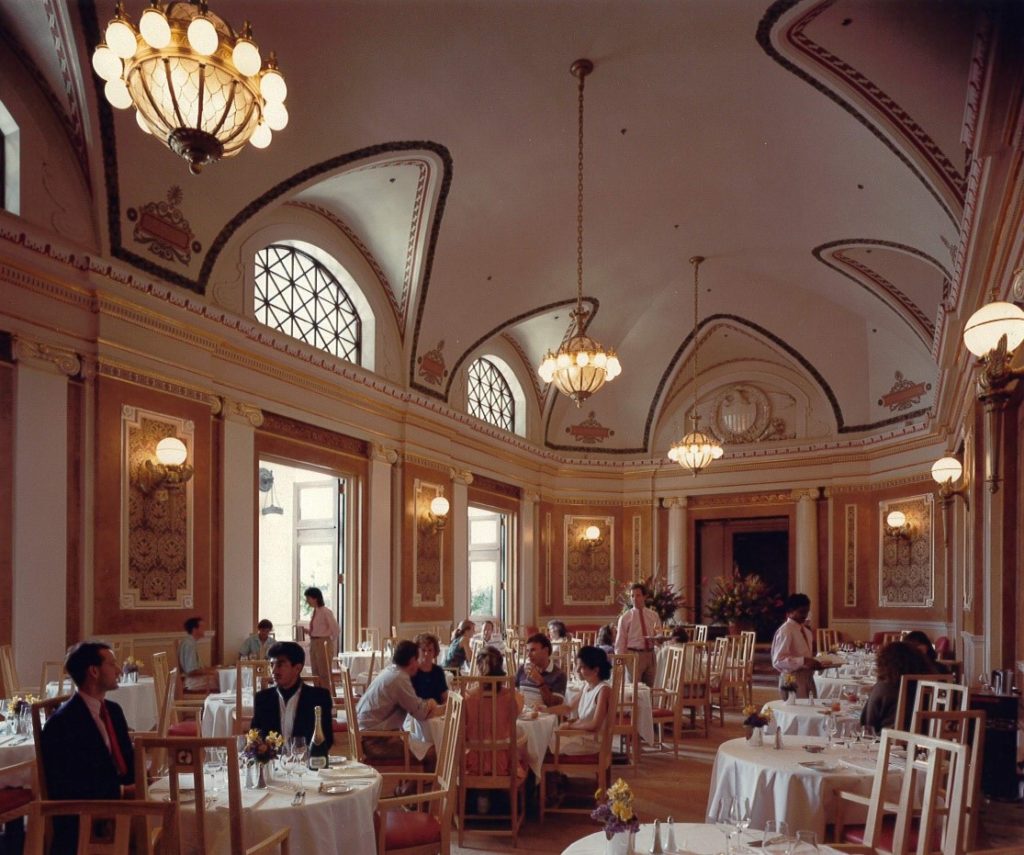Station Stories
List of Entries
The Life and Works of Daniel Burnham
Beaux-Arts Architectural Style at Union Station
Union Station Streetcar
The Presidential Suite at Union Station
The American Red Cross at Union Station
The Life and Works of Daniel Burnham
By Sara Kim, Former USRC Intern
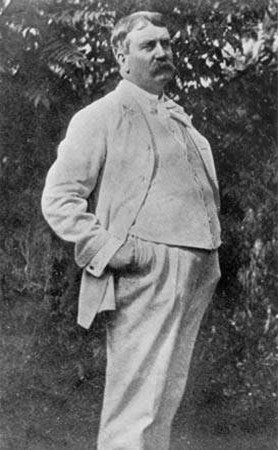
Daniel Burnham. (Photo courtesy of the Library of Congress.)
Born in Henderson, New York on September 4, 1846, Daniel Burnham would go on to design some of the greatest works in American history, including Washington, DC’s Union Station. At the age of 8, his family moved to Chicago; however, Burnham attended school in Waltham, Massachusetts. As a young man, he unsuccessfully attempted to get admitted to Harvard and Yale. Afterward, he moved to Chicago and worked under William Le Baron Jenney, an engineer and architect, also known as the “Father of the American Skyscraper”. Burnham later moved to Nevada in hopes of mining silver, but ended up working in the local political court. He ran for the Nevada State Senate, but failed to win a seat. After his political defeat in 1870, Burnham returned to Chicago to work in Peter Wright’s architecture firm where, in 1872, he met John Wellborn Root, his future business partner.
In 1873, they established Burnham and Root, a renowned architecture firm in Chicago, and designed many significant towers, including one of the first American skyscrapers, the Masonic Temple, in 1891. The two also spearheaded the design and construction of the World’s Columbian Exposition (also known as the Chicago World’s Fair) until Root’s unexpected death in 1891. Burnham continued with the project as its Director of Works and, through his leadership and guidance, the Exposition overcame financial and technical challenges within a pressing timeframe. By the time of its opening in 1893, the World’s Columbian Exposition was noted as the world’s largest fair. The Exposition brought Burnham great respect and recognition in the field and many cities began to seek his expertise.
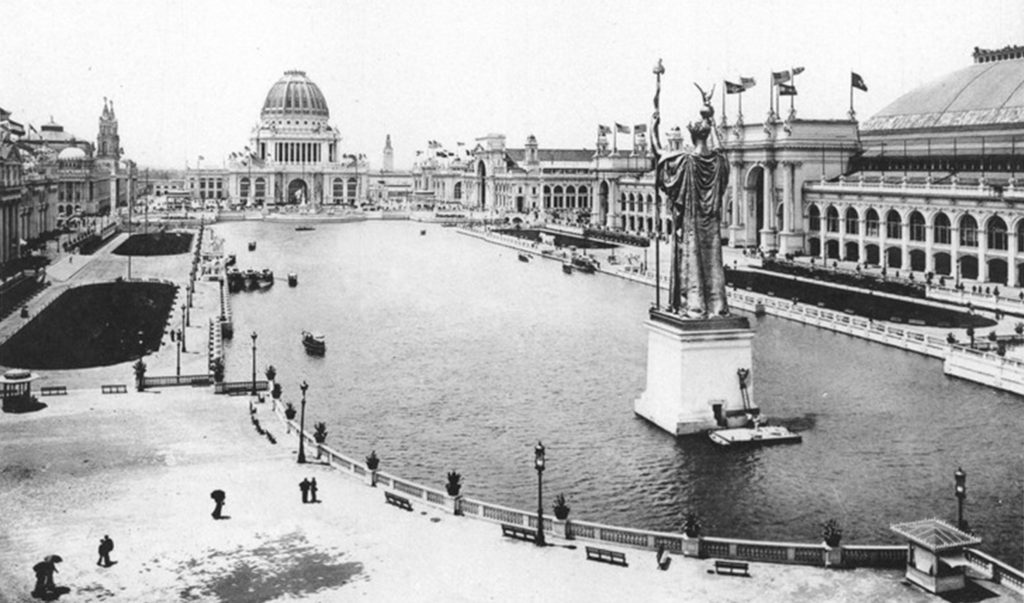
The Great Basin, the Court of Honor, and administrative buildings at the World’s Columbian Exposition. (Smithsonian Magazine, November 20, 2012.)
In 1901, Burnham was appointed to be a member of the U.S. Senate Park Commission, headed by Senator James McMillan of Michigan, which developed the McMillan Plan. Two key components of the McMillan Plan were the National Mall and Union Station. Burnham and his fellow Commission members, many of whom were colleagues from the World’s Columbian Exposition project, extended the National Mall beyond the Washington Monument to the Lincoln Memorial and provided the foundation for the Jefferson Memorial.
Union Station was another, perhaps more complex, part of the plan. The District was in urgent need of a new station that could house the growing capacity of transportation flow that the city was facing. In 1901, the Pennsylvania Railroad and the Baltimore and Ohio Railroad agreed to remove the tracks and terminals from the National Mall and finally build a station that met the aforementioned demands and matched the status of the city as the national capital. However, as with every monumental project, there was political dissent, financial complications, and community opposition. Nonetheless, under the direction and guidance of the U.S. Senate Park Commission and Burnham’s architecture firm, D.H. Burnham & Company, Union Station welcomed its first train in October 1907 and officially opened in 1908.
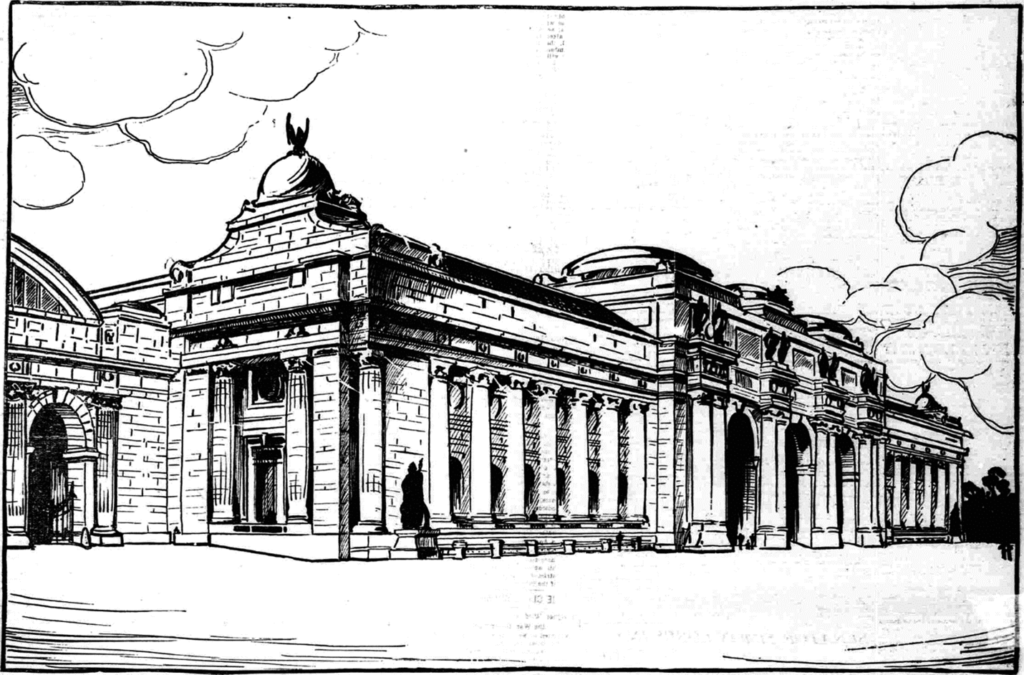
A 1902 design proposal for Union Station. (The Times, Washington, March 17, 1902, courtesy of the Library of Congress.)
As the McMillan Plan steadily came to a conclusion, from 1906 to 1909, Burnham took on The Plan of Chicago with Edward Bennett, an architect and urban planner. This plan was the first controlled growth plan for an American city and included various public spaces such as a lakefront, parks, and a central square consisting of major boulevards, fountains, and administrative buildings. Although the plan was only realized in parts, Burnham established an urban standard that continues to be widely referenced in Chicago. Afterward, Burnham continued to design and construct distinguished structures and landscapes in various cities around the United States and the world.
On June 1, 1912, in Heidelberg, Germany, Burnham’s life came to an end. He left behind his two sons, who followed in his footsteps, a daughter, and his wife Margaret Sherman. He also left an influential legacy that impacts millions of people every day. Many of his ideas, structures, and plans still stand and are in effect today. Burnham’s contribution to urban planning and architecture spanned through many cities beyond Chicago and Washington, DC, such as Cleveland, San Francisco, Pittsburgh, New York, and Manila and Baguio in the Philippines. He shaped many great American and international cities and influenced both the social and physical landscapes and accessibilities of them all.
Sources
• https://www.smithsonianmag.com/arts-culture/where-did-pabst-win-that-blue-ribbon-138975181/
• https://chroniclingamerica.loc.gov/data/batches/dlc_abe_ver01/data/sn87062245/100493007/1902031701/0231.pdf
• https://www.britannica.com/biography/Daniel-Burnham
• https://www.architecture.org/learn/resources/architecture-dictionary/entry/burnham-and-root/
• https://www.nps.gov/nationalmallplan/Documents/Studies/m2.pdf
• https://www.tclf.org/pioneer/dh-burnham-and-company
• http://mallhistory.org/items/show/88
Beaux-Arts Architectural Style at Union Station
By Jennifer Rouse, USRC Program Manager
Washington, DC’s Union Station was intended to be a grand gateway to the nation’s capital. The station, which was designed by Daniel Burnham, was built from 1905 to 1908 (with statuary and Columbus Plaza being completed in 1912). The Beaux-Arts architectural style, with key elements of grandiosity, symmetry, and elaborate ornamentation, was the perfect style choice to make an impression on visitors.
The Beaux-Arts architectural style (beaux arts meaning fine arts in French) originated from the École des Beaux-Arts, the School of Fine Arts, in France. This style, a subset of Greek Revival and Neoclassical architectural styles, was popular in the United States from the 1880s to 1930s. It was a part of the American Renaissance movement of the 19th Century and reflected the wealth and grandeur of the Industrial Revolution. Beaux-Arts borrowed from ancient Greek and Roman Architecture and the Baths of Caracalla and Diocletian and the Arch of Constantine of ancient Rome were key influences in the design of Union Station.
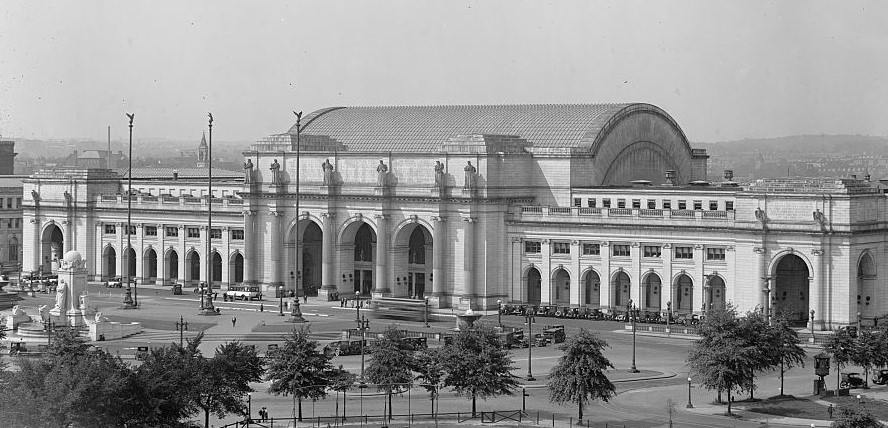
Union Station exterior, c. 1925. (Photo courtesy of the Library of Congress.)
Like Union Station, typical Beaux-Arts buildings are massive structures with a stone façade; are symmetrical in nature; and include a variety of classical architectural elements such as columns, archways, balustrades, and statuary. Built in white Bethel Granite, Union Station has a smooth stone exterior and the central pavilion of the front façade has three symmetrical grand archways surrounded by ionic columns. These columns are topped with allegorical statues of Greek gods, astronomers, and mathematicians, collectively entitled the “Progress of Railroading”. These statues represent six elements of the railroad industry: fire, electricity, mechanics, agriculture, imagination, and freedom. Cut into the stone, between these statues on a high frieze, are inscriptions written by Charles W. Eliot (President of Harvard University from 1869 to 1909), which describe each element the statues represent. For example, for the inscription for fire, symbolized by the statue of Prometheus, Eliot wrote “Fire – greatest of discoveries enabling man to live in various climates use many foods – and compel the forces of nature to do his work.”
On either side of the central façade are arcades (covered passageways with arches) covered with ionic pilasters, leading to the east and west pavilions on either end. The pavilions contain smaller archways and ionic columns below the granite eagle statues and additional inscribed frieze panels.
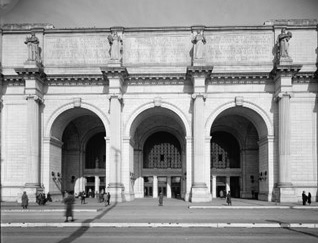
The central pavilion showing the large archways and ionic columns below the engraved frieze and Progress of Railroading statues. c. 1921. (Photo courtesy of the Library of Congress.)
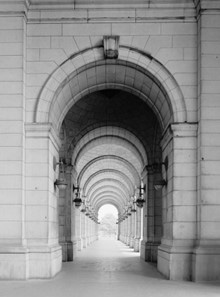
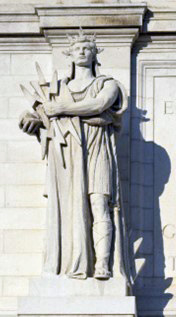
Left: The arcade at the front façade looking west, c. 1933. (Photo courtesy of the Library of Congress.) Right: Close-up view of Thales from the “Progress of Railroading” statues. (Photo credit: Carol Highsmith, c.1980, courtesy of the Library of Congress.)
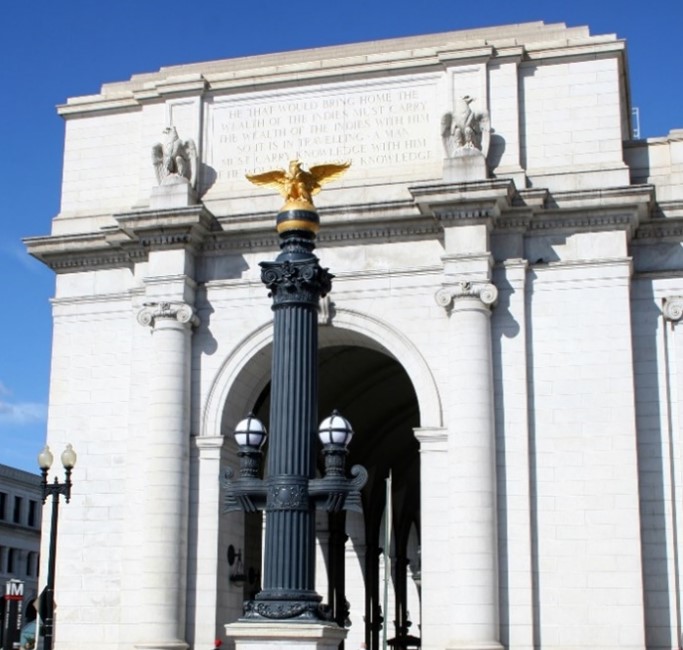
The West Portico and a Rostral Column, 2019.
Some areas in the interior of Union Station have different classical architectural styles; however, the Main Hall continues the Beaux-Arts style from the exterior. At the time of construction, the Main Hall was thought to be the largest room in the world with its monumental space that is 120’ wide by 220’ long with a 96-foot-tall Roman barrel-vaulted ceiling. The ceiling contains 255 octagonal coffers with detailed egg and dart molding and gold leaf in the center. Along the perimeter of the Main Hall is a peristyle (row of columns surrounding a space) of Doric columns topped by a classical entablature. Around the Main Hall, above the columns, are 36 Roman Legionnaire statues in arched alcoves with gold leaf coffers.
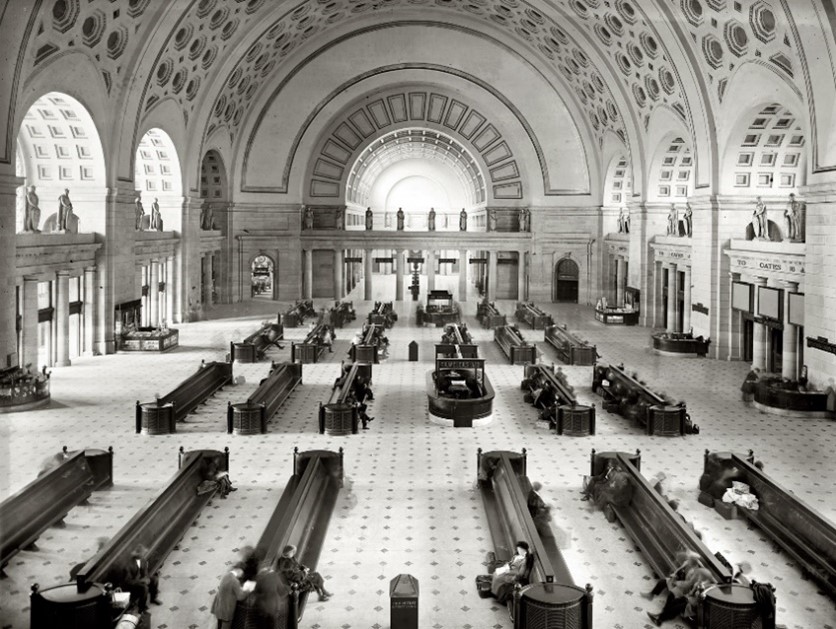
Main Hall looking west, c. 1921. (Photo courtesy of the Library of Congress.)
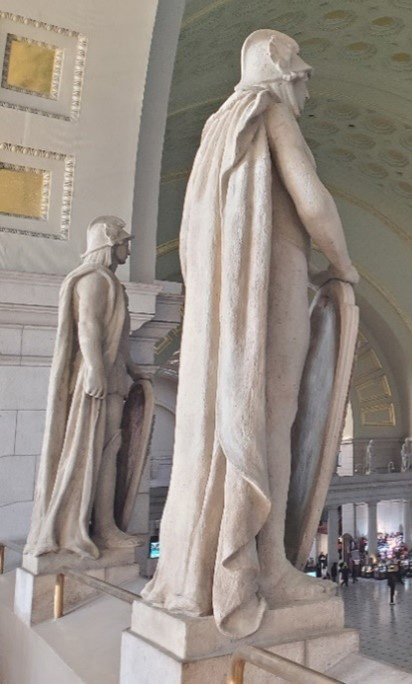
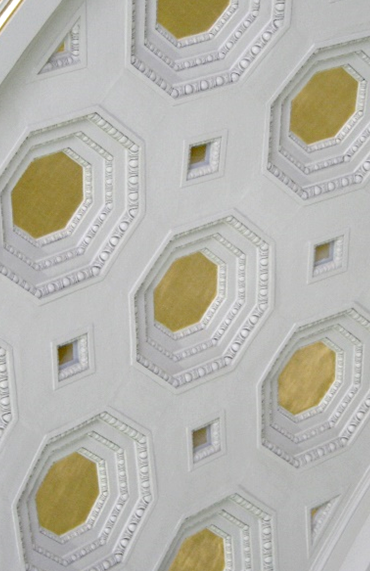
Left: Roman Legionnaire statues from the south alcove, 2020. Right: Main Hall ceiling coffers, 2019.
For many years, Beaux-Arts architecture became a popular style in the nation’s capital and, in addition to Union Station, its influence can still be seen throughout the District today. One such building, located just next door to Union Station, is the National Postal Museum (constructed in 1914). It served as the main post office of Washington, DC until 1986 and was also designed by Daniel Burnham. Other examples in Washington, DC include the Library of Congress Thomas Jefferson Building (constructed from 1890 to 1897), the Russell Senate Office Building (constructed from 1903 to 1908), and the U.S. Chamber of Commerce Building (built from 1922 to 1925).
Sources
• https://www.aoc.gov/explore-capitol-campus/buildings-grounds/beaux-arts
• https://www.architecture.org/learn/resources/architecture-dictionary/entry/beaux-arts/
• http://lcweb2.loc.gov/service/gdc/scd0001/2001/20010403001in/20010403001in.pdf
• http://www.phmc.state.pa.us/portal/communities/architecture/styles/beaux-arts.html
• https://www.britannica.com/biography/Charles-William-Eliot
Union Station Streetcar
By Miles Stepleton, Former USRC Intern
When the Capital Traction and Washington Railway and Electric companies began offering streetcar service at Union Station in summer 1908, it had been almost 50 years since the first streetcar had begun operation in 1862. The Union Station line connected the rail hub to the sprawling network of Capital Traction and Washington Railway and Electric streetcar lines that stretched all across the District.
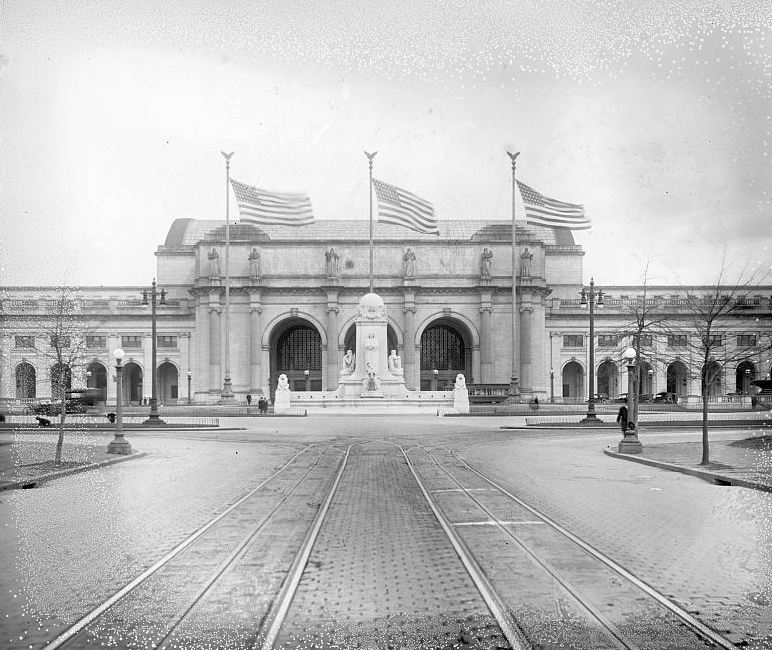
Tracks going to Union Station, 1916. (Photo courtesy of the Library of Congress.)
Washington, DC’s original streetcars, which were pulled by horses, shared roads with pedestrians and horse-drawn carriages. The rise in automobiles eventually replaced carriages on the city’s streets, but the streetcar remained. New technological innovations quickly led to the development of an underground cable system, run by a steam powerhouse on Pennsylvania Avenue. These cables would pull the streetcars, which latched onto the underground cable via an arm that extended from its undercarriage.
By the time the streetcar made it to Union Station in 1908, DC’s streetcars had been electrically powered for almost two decades. The city’s streetcar network had also been consolidated by the Capital Traction and Washington Railway and Electric companies from a patchwork of different streetcar lines into an organized network of electric streetcars with tracks that crisscrossed the city.
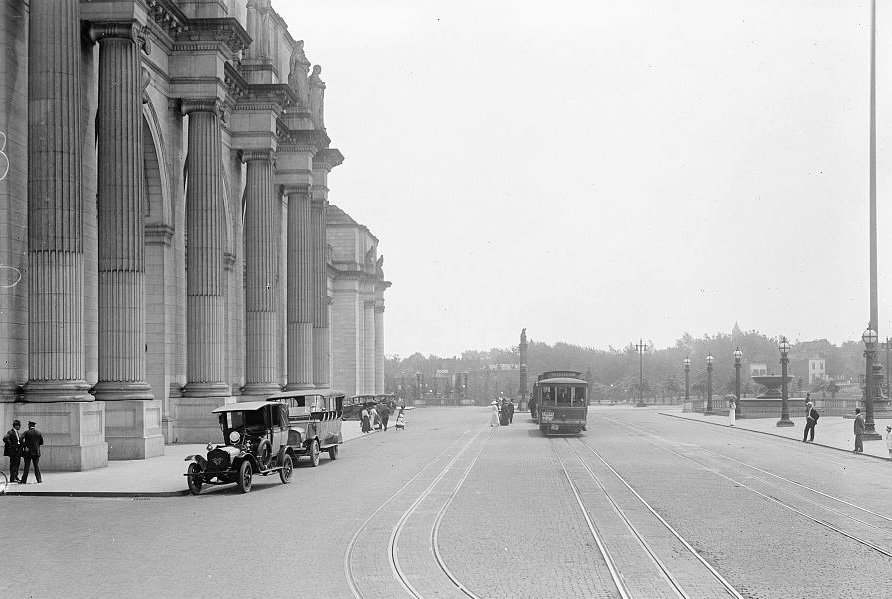
The streetcar and cars outside Union Station c. 1913. (Photo courtesy of the Library of Congress.)
For almost two decades, starting at the turn of the 20th century, the streetcar was a vital element of life in the District. As the size of the federal government burgeoned, streetcars connected the previously distinct neighborhoods of Washington, DC, allowing federal employees and residents more freedom in where they lived. The connective capacity of the streetcar was greatly enhanced with the addition of the Union Station line, enabling easy travel from DC’s more distant neighborhoods to the station.
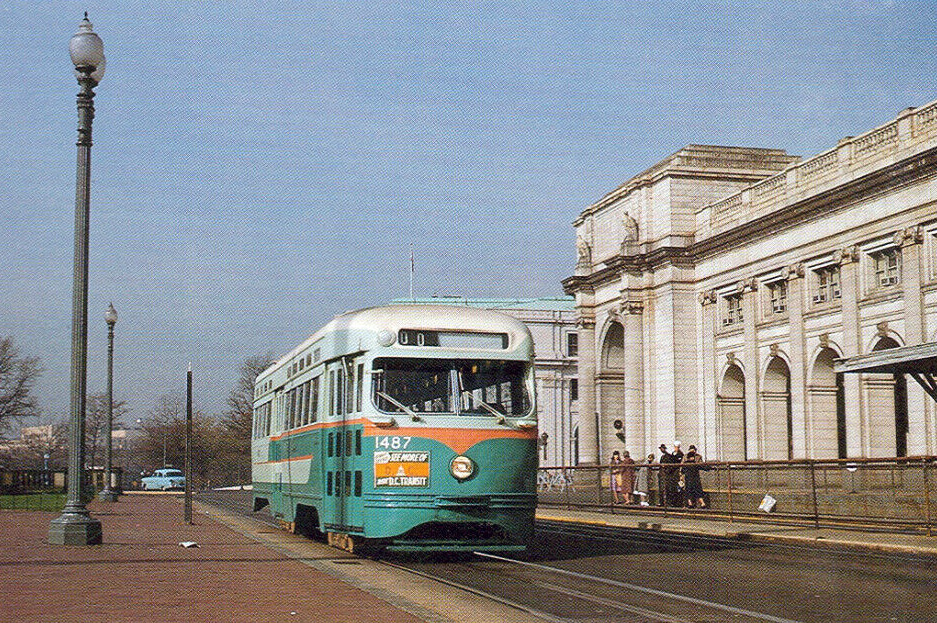
Streetcars in front of Union Station in the 1950s. (Photo courtesy of Streets of Washington.)
Streetcar ridership remained high and a central aspect of the capital until the 1920s. By then, the introduction of a bus system in Washington, DC, combined with the rise of the personal automobile and increased corporate dysfunction led to a decline in streetcar ridership. However, the streetcar was far from finished. Gas and rubber rationing during World War II made streetcars a more practical and economical way to travel and DC’s streetcars, operated exclusively by the Capital Transit Company, saw their ridership rise through the 1940s. This rise in ridership was accompanied by the construction of a bus and trolley marquee in front of the station. This structure established an official stop in front of Union Station, which was used for both the city’s streetcars and buses concurrently.
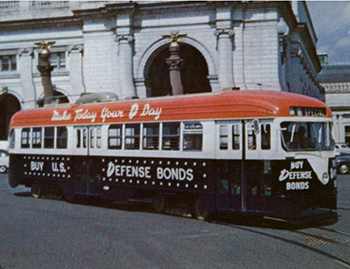
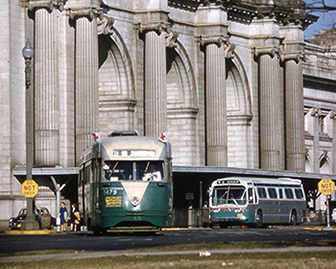
Left: Streetcar with an ad for Defense Bonds, 1951. Right: Streetcars at the official stop in front of Union Station, 1950s. (Source Unknown.)
Despite their mid-century rally, it became clear by the 1950s that the streetcar’s days were numbered. Due to the ban on overhead power lines (intended to protect views of the nation’s capital), the streetcar’s power source had to be buried between the tracks. This design was expensive to maintain, because, in the winter, the powerlines would be jammed with snow and ice and, in the summer, the metal tracks would expand, blocking access to the powerlines. Jammed powerlines became an almost everyday occurrence, increasing travel times and discouraging ridership.
In 1955, these problems were only compounded by a seven-week work stoppage. Capital Transit Company bus drivers and streetcar operators walked out of negotiations after being denied a 25-cent increase in hourly wages. When the strike finally ended and service resumed, ridership on streetcars and buses dropped between ten and 25 percent as many commuters had turned to driving cars to get to work while transit was shut down. The strike forced Congress to revoke Capital Transit’s federally approved charter, which ultimately led to the company’s Congressionally approved purchase by O. Roy Chalk on the condition that he phase out streetcar service by 1963. On January 27, 1962, the streetcar’s last day of operation, some operators displayed an old-fashioned wooden trolley from 1919 in front of Union Station draped with a funeral wreath hung over the headlight.
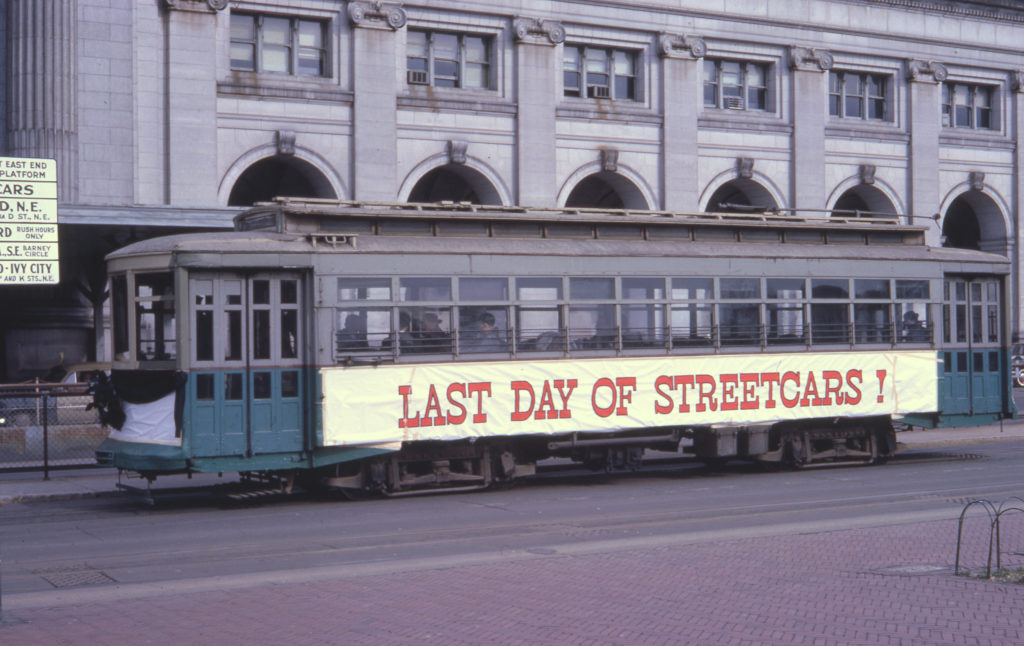
This photo announcing the last day the streetcars would be in operation was taken on January 27, 1962. (Photo courtesy of the Central Electric Railfans’ Association.)
Skipping ahead to 1997, more than 30 years after the city paved over the streetcar entrances at Union Station, the DC Department of Public Works published a 20-year vision for bringing the streetcar back to Washington, DC. That vision was followed by extensive planning, revision, and testing. Repeated budget cuts and shaky construction efforts meant that what had been envisioned as four streetcar lines, stretching more than 35 miles, was reduced to a single line, servicing a 2.2 mile corridor of northeast DC, running eastward from Union Station to the Anacostia River. While not nearly as extensive as the streetcars of the 20th century, the modern DC Streetcar facilitates travel where other transit options are more limited. The streetcar’s location north of the Union Station Parking Garage on H Street NE further enhances its effectiveness by allowing travelers and commuters an additional route of accessible transportation to and from the station.
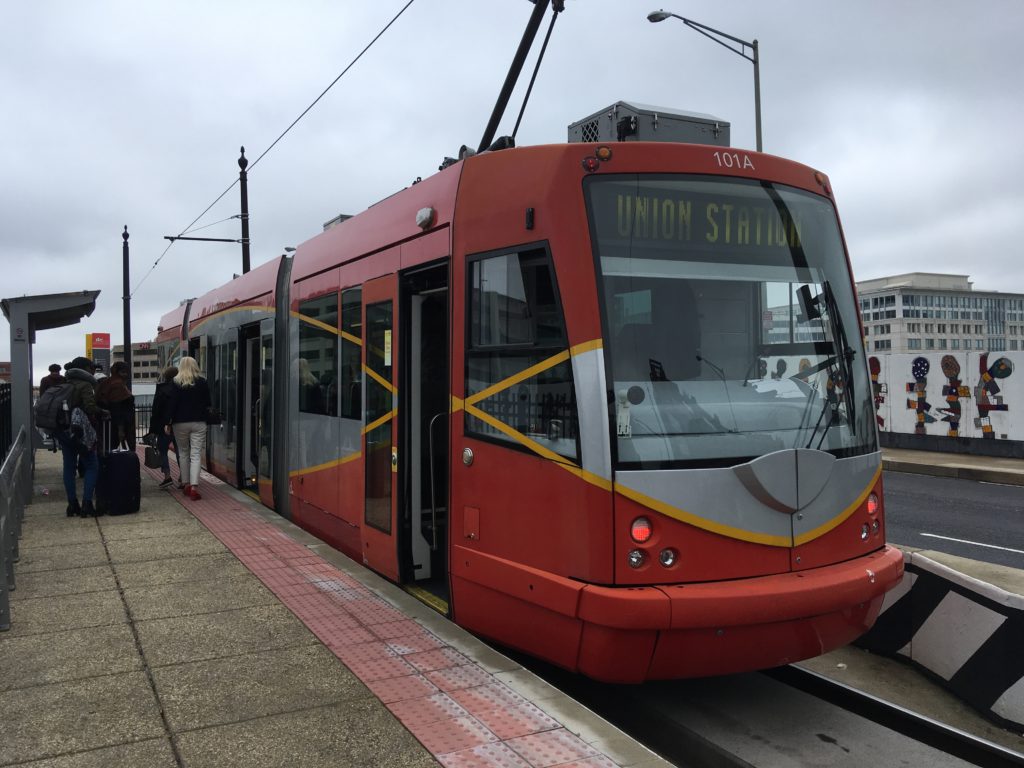
The streetcar on the H Street Bridge north of Union Station, 2017.
Sources
• https://dc.curbed.com/2017/9/21/16342496/streetcar-dc-washington-history
• https://wamu.org/story/15/09/11/capital_streetcars_a_joyride_through_dcs_transit_history/
• https://www.washingtonpost.com/local/driven-to-fail-heres-the-story-of-the-demise-of-the-districts-streetcars/2015/03/28/4d822bb6-d48e-11e4-a62f-ee745911a4ff_story.html
• https://blogs.weta.org/boundarystones/2014/01/27/dcs-once-grand-streetcar-system#overlay-context=2013/11/20/demise-dcs-original-streetcar-system
• https://blogs.weta.org/boundarystones/2014/01/28/demise-dcs-streetcars
• https://www.atlasobscura.com/places/dupont-underground
• https://ggwash.org/view/37880/a-history-of-streetcar-planning-in-the-district
• https://nextcity.org/daily/entry/dc-streetcar-starts-service-response
• https://www.jstor.org/stable/j.ctt3fhhrf
• https://www.jstor.org/stable/90007381
• https://www.washingtonpost.com/local/all-aboard-for-a-bit-of-dc-streetcar-nostalgia/2015/03/21/b3ae8db6-cf21-11e4-8c54-ffb5ba6f2f69_story.html
• https://ceramembersblog.wordpress.com/2013/12/16/streetcars-return-to-dc/
The Presidential Suite at Union Station
By Sarah Mayersohn, USRC Document/Archive Manager and Jillian Hess, USRC Public Relations and Outreach Manager
When Congress authorized the construction of a new railroad terminal that would unite the two major railroads, the Baltimore and Ohio (B&O) and Pennsylvania, in the nation’s capital in 1903, there had been two recent presidential assassinations in public places: President James Garfield at the Baltimore and Potomac Station in Washington, DC in 1881 and President William McKinley on the grounds of the Pan-American Exposition at the Temple of Music in Buffalo, New York in 1901. Taking that into consideration, Daniel Burnham, the station’s architect, incorporated a separate and grander entrance to be reserved for the use of the President, as well as visiting foreign dignitaries. As a result, one of the most elaborately designed spaces in Washington Union Station, located on the southeast side, has a large reception room, several small private offices, and large wooden entryways within the front portico and the original passenger concourse.
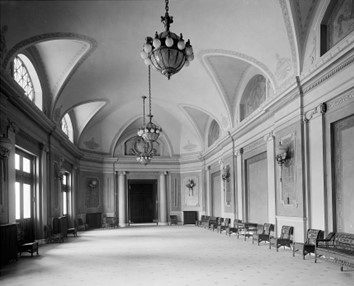
The Presidential Suite Reception Room, c. 1910. (Photo courtesy of the Library of Congress.)
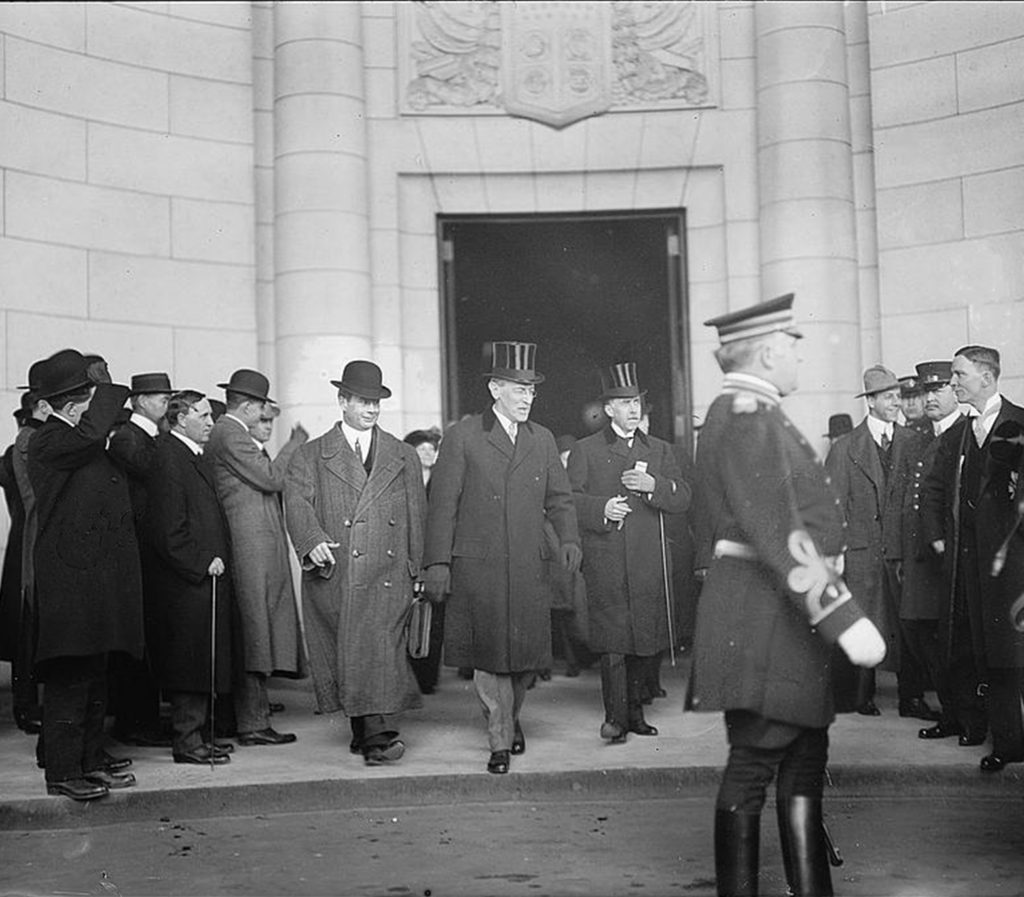
President Woodrow Wilson and his entourage leaving the Presidential Suite for his inauguration in March 1913. (Photo courtesy of the Library of Congress.)
Every U.S. President from William Howard Taft to Harry Truman used the Presidential Suite, whether it was for train travel or receipt of important visitors. For example, in this space, President Calvin Coolidge welcomed Queen Marie of Romania in October 1926, President Herbert Hoover greeted King Prajadhipok of Siam (now Thailand) in April 1931, and President Franklin D. Roosevelt met President Manuel L. Quezon of the Philippines in May 1942.
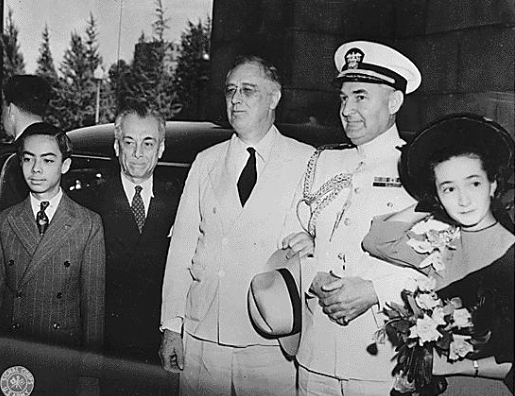
Philippines President Manuel L. Quezon, his son Manuel L. Quezon, Jr., and his daughter Maria Aurora Quezon being greeted by U.S. President Franklin D. Roosevelt and U.S. Navy Captain John McCrea upon their arrival in Washington, DC in May 1942. (Photo from the Franklin D. Roosevelt Library, courtesy of the National Archives.)
Most notably, President Franklin D. Roosevelt and First Lady Eleanor Roosevelt greeted King George VI and Queen Elizabeth (who were accompanied by Canadian Prime Minister Mackenzie King) in the Presidential Suite Reception Room during their visit (and the first visit of any British monarchs) to the United States in June 1939.
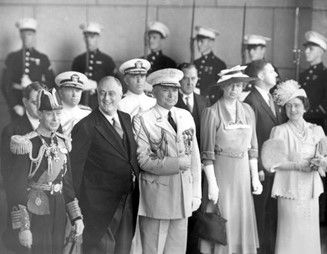
King George VI, President Franklin D. Roosevelt, U.S. Navy Captain John McCrea, First Lady Eleanor Roosevelt, and Queen Elizabeth outside the Presidential Suite of Union Station in June 1939. (Photo from the Franklin D. Roosevelt Library, courtesy of the National Archives.)
While the primary intent of the Presidential Suite was for safeguarding the President while traveling, it was not always used this way. During World War I, the American Red Cross used the space as a canteen for soldiers traveling through the station. Decades later, as part of the Second World War effort, the United Service Organizations (USO) took over the Presidential Suite to create a lounge for traveling soldiers from 1942 to 1946. After the war, President Harry Truman rarely used the Presidential Suite, so in 1951, he bequeathed the space to the USO as a “home away from home” for traveling Armed Forces members.
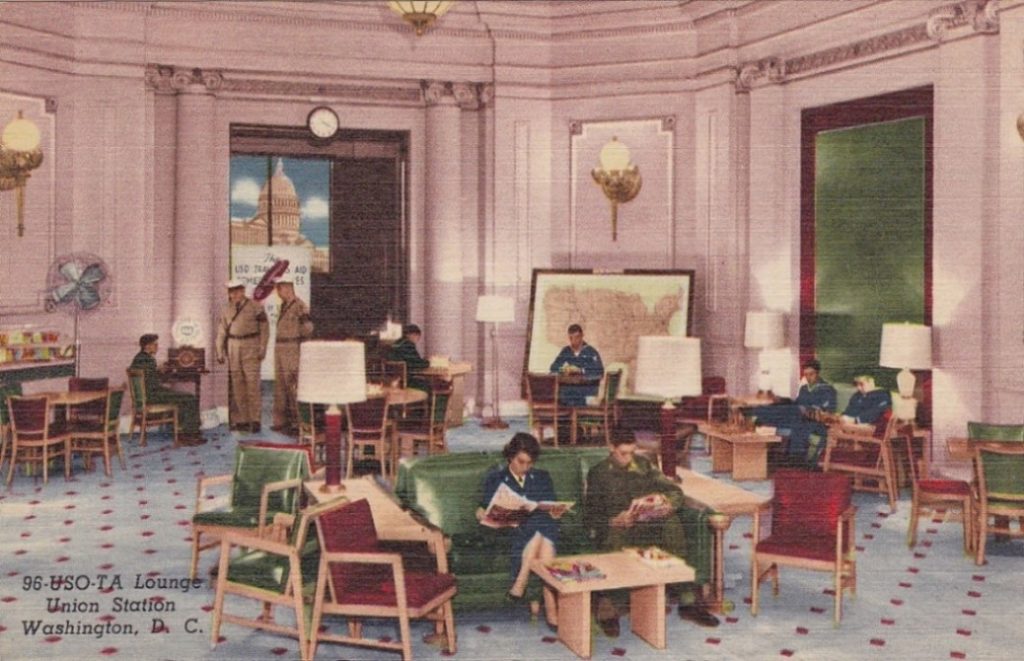
Postcard of the USO-TA Lounge in the Presidential Suite, c. 1950.
During the 1980s, the Presidential Suite was restored to its original grandeur. Post-restoration, it was used as a restaurant. From the mid-1980s to 1992, the space housed the Adirondacks Restaurant and from 1994 to 2013, it was the B. Smith’s Restaurant.
Currently, the Presidential Suite is reserved for private events organized by Special Events at Union Station.
INSERT AN EVENT PHOTO OR THE RECENT ONE WITHOUT CARPET OR ANYTHING.
Sources
https://govtrackus.s3.amazonaws.com/legislink/pdf/stat/32/STATUTE-32-Pg909.pdf
https://www.history.com/news/the-assassination-of-president-james-a-garfield
https://www.history.com/news/the-assassination-of-president-william-mckinley
https://rollcall.com/2003/07/22/a-kings-welcome/
http://www.positivelyfilipino.com/magazine/the-quezons-at-the-white-house
https://www.youtube.com/watch?v=tDB-coIYtFI
https://www.washingtonpost.com/business/capitalbusiness/b-smiths-restaurant-in-union-station-to-close-after-almost-20-years-in-business/2013/09/13/f1fc4c1e-1c91-11e3-82ef-a059e54c49d0_story.html
https://www.americanheritage.com/queen-marie
American Blues, Jazz & Soul Food, 2nd Edition By Ron Rudison, February 18, 2016. (no link available)
The American Red Cross at Union Station
By Sarah Mayersohn, USRC Document/Archive Manager and Jillian Hess, USRC Public Relations and Outreach Manager
During World War I, the American Red Cross was active at Union Station. In March 1917, it opened a first aid station with ten beds and two ambulances. Dr. H. T. A. Lemon oversaw a staff of 25 doctors and five nurses. This was one of five emergency hospitals that opened in the District during the war.
Additionally, the American Red Cross established a Home Service Information Desk in the Main Hall, which featured a 16-inch naval shell for collection for the war service fund. They also placed Red Cross posters in the station to increase awareness about the war service fund.
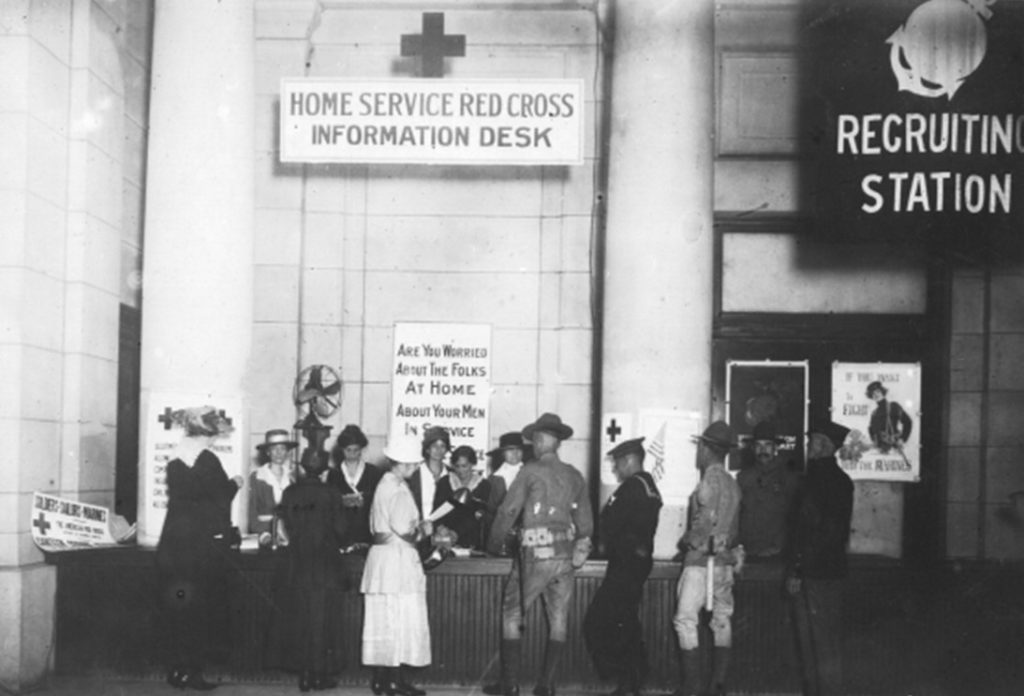
The American Red Cross Home Service Information Desk in the Main Hall, c. 1918. (Photo courtesy of the National Archives.)
In addition, the Red Cross offered a canteen service in the railyards where volunteers would distribute coffee and sandwiches to soldiers passing through the District by train. They also took mail from the soldiers on the trains who did not have time to go to the post office.
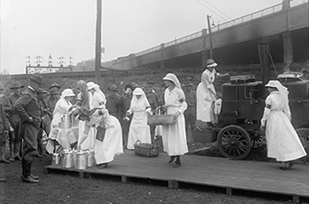
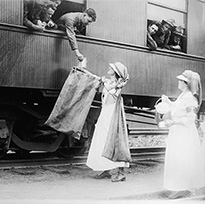
Left: The railyard canteen. Right: The railyard mail service. (c. 1917 photos courtesy of the Library of Congress.)
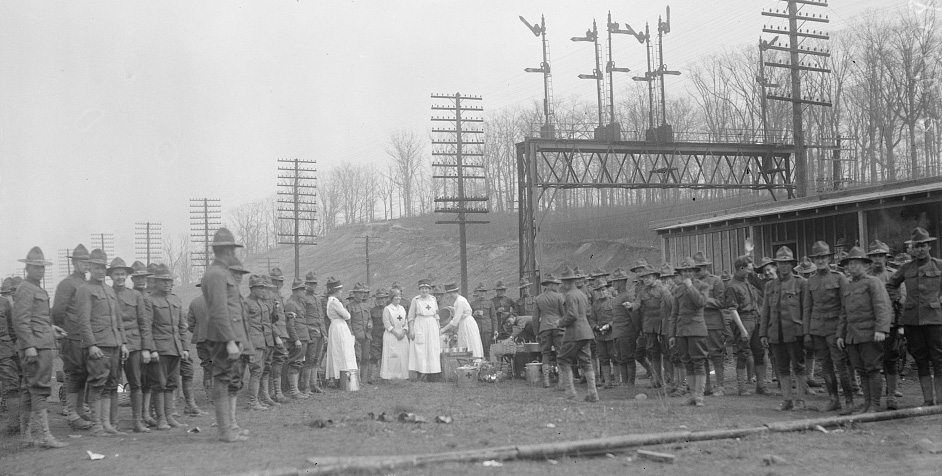
The American Red Cross railyard canteen, c. 1917. (Photo courtesy of the Library of Congress.)
In June 1918, President Woodrow Wilson authorized the use of the Presidential Suite by the Washington, DC Chapter of the American Red Cross, which they turned into a canteen. This was the first time in the station’s history that the Presidential Suite had been used for anything other than official state functions.
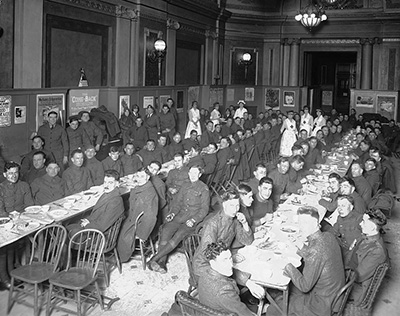
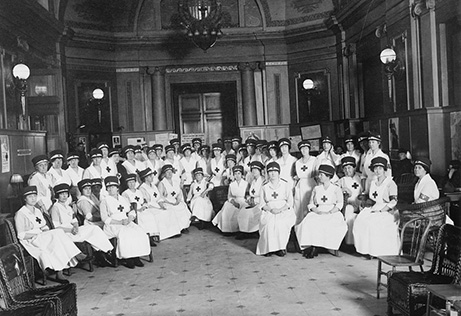
Soldiers and volunteers in the Red Cross canteen in the Presidential Suite, c. 1918. (Photo courtesy of the Library of Congress.)
The canteen, which was staffed by Red Cross volunteers and was open from 6:00 am to 12:00 am, served thousands of soldiers each day. The canteen remained open into 1920, even though the war had already ended. At this point, its focus shifted to the wounded veterans from Walter Reed and St. Elizabeth’s Hospitals.
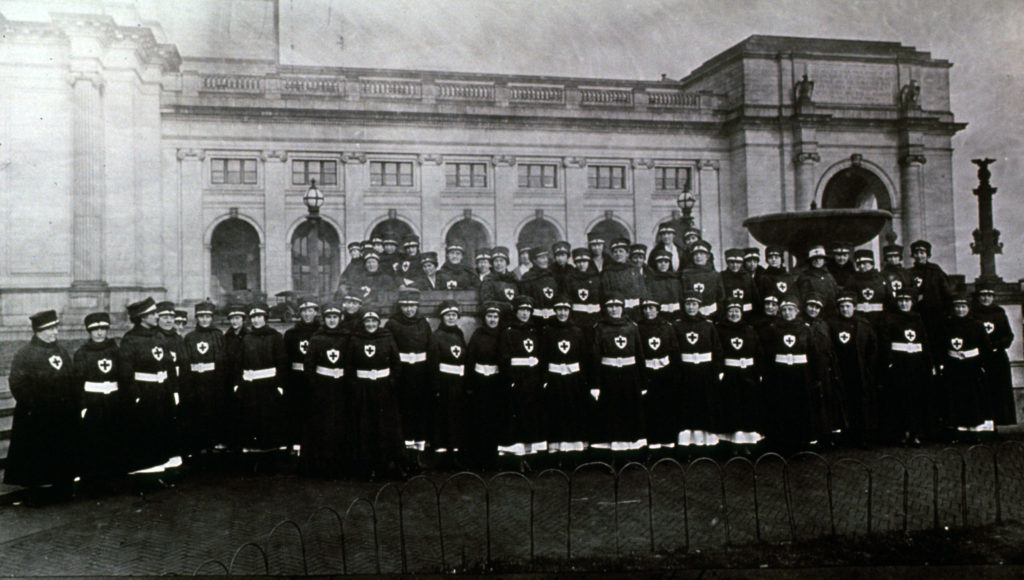
A group of Red Cross volunteers in front of Union Station, 1919. (Photo courtesy of the Library of Congress.)
Sources
• https://chroniclingamerica.loc.gov/lccn/sn84026749/1917-03-01/ed-1/seq-4/
• https://chroniclingamerica.loc.gov/lccn/sn83045462/1917-09-16/ed-1/seq-12/
• https://chroniclingamerica.loc.gov/lccn/sn84026749/1917-03-01/ed-1/seq-4/
• https://chroniclingamerica.loc.gov/lccn/sn83045462/1920-02-06/ed-1/seq-11/
• “Service Men Get Wilson’s Suite: President Turns Over Quarters at Union Station for Canteen”, The Washington Post, June 17, 1918. (no link available)


